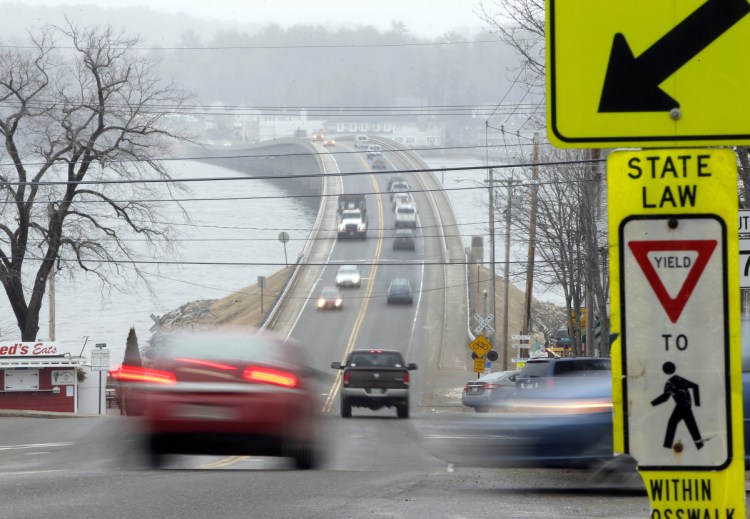WISCASSET — An overwhelming majority of residents voted Tuesday to end the town’s controversial lawsuit against the Maine Department of Transportation over the agency’s efforts to ease the notorious summertime traffic congestion in the historic village.
Out of 881 total votes cast, 578 people, or about 66 percent, voted against continuing the lawsuit, while 303 voted to keep it moving forward.
Select Board member Katherine Martin-Savage, a proponent of the lawsuit, said she was disappointed, but she hopes the town is able to move forward as a community. Martin-Savage voted early Tuesday and returned to the polling center to learn the result of the election.
“It’s going to take some time, but life is too short to hold on to things,” Martin-Savage said after the result was announced.
Town Clerk Linda Perry said about 30 percent of the town’s 2,900 registered voters cast ballots in the special election, including 200 people who had already voted via absentee ballots. For perspective, she said there was about 75 percent turnout for the 2016 presidential election.
The town sued the Maine Department of Transportation on Nov. 28 over the state’s $5 million plan to ease the summertime traffic bottlenecks in the village center after Gov. Paul LePage’s administration allegedly backed away from key promises and asserted the state didn’t have to comply with local ordinances.
“MaineDOT is gratified that the citizens of Wiscasset have again spoken loudly and clearly in support of MaineDOT’s downtown Wiscasset improvement project,” Ted Talbot, the department’s press secretary, said in a statement Tuesday night. “Like the majority of voters, MaineDOT believes that it is in the best interests of Wiscasset and of the region to move forward with the project rather than to continue to litigate the Town’s lawsuit. MaineDOT looks forward to the day when it can once again engage in productive discussions with Town leaders so that the parties can work together on the implementation of the project.”
Last week, lawyers for both sides argued before a justice of the Business and Consumer Court in Portland after the town filed a motion for a preliminary injunction to halt work on the project. The MDOT put the project out for bid in March and is set to open the bids Wednesday, and it is unclear how the result of the election will affect the bid process.
Superior Court Justice M. Michaela Murphy did not make a decision after two days of arguments by attorneys and testimony from a Wiscasset business owner, William Pulver, and Maine DOT project manager Ernie Martin.
Selectman Ben Rines Jr., a proponent of the lawsuit,was the first person to vote Tuesday morning. He said no matter how the vote turned out, he hopes the town can come together and move forward.
“I think the town’s vote will be respected,” he said.
Resident Anne Leslie, who hoped the people in Wiscasset would vote to continue the lawsuit, was one of the few people who voted around 8 a.m.
“I feel really strongly about the future of the village, and I feel that MDOT has just bulldozed its way through the town,” Leslie said. “I think the lawsuit is important because it’s about whether MDOT can ignore town laws.”
Brad Sevaldson, a member of the community group Wiscasset Moves Forward, which opposed the lawsuit, said members went door to door in the last few weeks urging people to get out and vote.
In a motion filed in early March, attorneys for the town said MDOT told them it might simply drop a component of the project – creating parking lots away from Main Street – if the department is required to obtain historical appropriateness approvals.
The motion asked the Business and Consumer Court to prevent any work on any part of the project from commencing until the department seeks and receives the town’s historic preservation review.
The MDOT has contended that the town’s historic preservation ordinance is not a zoning ordinance, and therefore it isn’t forced to comply with the ordinance under state law.
The town argued that the project, and numerous components, must comply with the town’s historic preservation ordinance and must receive one of more certificates of appropriateness from Wiscasset’s historic preservation commission.
The center of Wiscasset’s village is a district of 18th- and 19th-century buildings named to the National Register of Historic Places in 1973.
There are daily and infamous summertime traffic jams 2 to 3 miles long on U.S. Route 1 on the north and south approaches to the Davey Bridge, which spans the Sheepscot River. The state has been trying to solve the problem for more than 50 years.
The state’s latest plan was unveiled two years ago and promised to improve traffic flow at its worst by 12 percent to 14 percent, mostly by adding two traffic lights and curb extensions in the village – components that nobody opposes.
But it also seeks to remove parking on Main Street – currently 23 spaces – and parts of key side streets, measures that the state says account for just 2 percent to 4 percent of flow improvement.
Jason Pafundi can be contacted at 621-5663 or at:
jpafundi@mainetoday.com
Send questions/comments to the editors.



